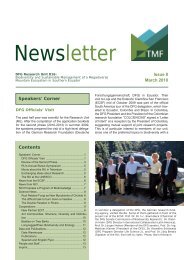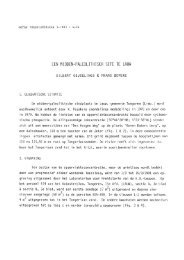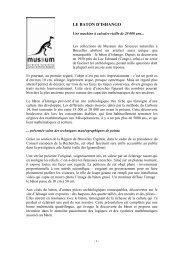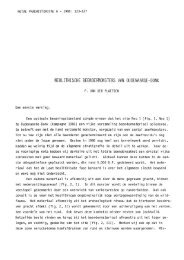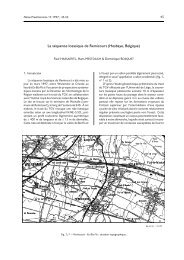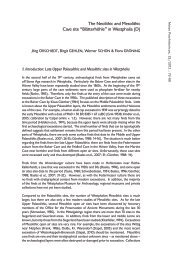Terebratula Daleidensis - Royal Belgian Institute of Natural Sciences
Terebratula Daleidensis - Royal Belgian Institute of Natural Sciences
Terebratula Daleidensis - Royal Belgian Institute of Natural Sciences
You also want an ePaper? Increase the reach of your titles
YUMPU automatically turns print PDFs into web optimized ePapers that Google loves.
50 Paul SARTENAER<br />
MauReR (1896, p. 657) was less accommodating<br />
in expressing his conviction that the “forms” from the<br />
Rhenish Lower Devonian could not be considered as<br />
being the same species as R. livonica. Focusing on R.<br />
daleidensis and R. livonica, GüRich (1909, p. 146)<br />
wrote: “Da diese Arten im Unter- und Mitteldevon im<br />
Fluss sind, hält es schwer Grenzformen als besondere<br />
Arten heraus zu greifen”. In adopting a wider vision,<br />
Reed (1922, p. 95), who had already (1921, p. 317)<br />
recognized “a considerable range <strong>of</strong> variation” in R.<br />
daleidensis, considered that R. daleidensis, R. inaurita,<br />
R. Pareti, R. Partridgiae WhidboRne, 1897 and<br />
R. turanica “should be regarded as synonyms <strong>of</strong> R.<br />
livonica, or at any rate not worthy <strong>of</strong> ranking above<br />
varieties”. This was the last attempt to mistake various<br />
species for the Lower Frasnian species Ripidiorhynchus<br />
livonicus, as the Latvian species is known nowadays;<br />
these species, <strong>of</strong> which some are discussed in the<br />
present paper, are independent taxa.<br />
inaurita versus daleidensis<br />
When the SandbeRgeR brothers (1856, pp. 337-338,<br />
pl. XXXIII, figs 5, 5a-c) established Rhynchonella<br />
inaurita, they included in it three previously described<br />
species (<strong>Terebratula</strong> livonica, T. <strong>Daleidensis</strong>, and<br />
T. Huotina), and, thus, the priority should have been<br />
given to the oldest known species, T. livonica. At the<br />
same time, they gave to the new species a considerable<br />
stratigaphic range - Oriskany Sandstone (Pragian) to<br />
Stringocephalenkalk - and a vast geographic distribution:<br />
France (Boulonnais, Normandy), Germany (Dill<br />
Syncline, Eifel, Lahn Syncline, middle Rhine valley,<br />
Taunus), Latvia, Pensylvania, and Russia (Central and<br />
Main Devonian Fields, Pechora, W Siberia). After<br />
examination <strong>of</strong> specimens <strong>of</strong> Rhynchonella livonica<br />
from the Syas’ river, von SandbeRgeR (1889, p. 13)<br />
dropped any doubt he had so far concerning the identity<br />
<strong>of</strong> R. livonica with R. inaurita (= R. daleidensis), and<br />
stated that he believed, like Venyukov (1886), that<br />
there was no palpable (“greifbare”) difference between<br />
the two species.<br />
Rhynchonella inaurita has usually been considered<br />
a junior synonym <strong>of</strong> <strong>Terebratula</strong> <strong>Daleidensis</strong>, e.g. by<br />
KRantz (1857, p. 150), RomanowSki (1880, p. 111),<br />
GoSSelet (1887, p. 194), MauReR (1896, p. 656),<br />
DReveRmann (1904, p. 262), GüRich (1909, pl. 45,<br />
figs 6a-d), who went as far as choosing SandbeRgeRs’<br />
figures (pl. XXXIII, figs 5, 5a-c) <strong>of</strong> Rhynchonella<br />
inaurita to illustrate R. daleidensis, and Maillieux<br />
(1931, p. 24). DavidSon (1870, pp. 72, 75, 78-81,<br />
87, pl. 5, figs 1-3; 1881, p. 341, pl. 38, fig. 21?, figs<br />
35a,b) recognized the species in the Upper Devonian<br />
<strong>of</strong> Devonshire. This strange and false occurrence<br />
was apparently based on identification by GoSSelet.<br />
Kay S e R (1871b), Venyukov (1886), and Loewe (1913)<br />
assigned the species to R. livonica (see above). Kay S e R<br />
(1878, pp. 142-143) recognized its validity, but later<br />
(1889, pp. 44-45) questioned separation <strong>of</strong> R. inaurita<br />
and R. daleidensis. BaRRoiS (1882, p. 267) considered<br />
R. inaurita as “très voisine” <strong>of</strong> R. daleidensis, R.<br />
livonica, and R. Pareti, and Reed (1922, p. 95) took<br />
the position indicated above under the discussion <strong>of</strong><br />
daleidensis versus livonica.<br />
As already indicated, the author considers inaurita<br />
as a valid taxon, and in so doing, he falls in with<br />
GoSSelet’s (1887, p. 194) suggestion that the name<br />
inaurita could be given to <strong>Terebratula</strong> <strong>Daleidensis</strong><br />
as described by SchnuR (1853) if it is accepted that<br />
it is different (“si on admet cette différence”) from T.<br />
<strong>Daleidensis</strong> as originally described by RoemeR (1844)<br />
(see above). Of course, one will have to forget the<br />
synonymy, the stratigraphic range, and the geographic<br />
distribution proposed by the SandbeRgeR brothers for<br />
the species they established.<br />
The species is included in a new genus in the present<br />
paper.<br />
daleidensis versus pareti<br />
When establishing Hemithyris Pareti, de VeRneuil<br />
(1850a, pp. 160, 162, 177) mentioned that the species<br />
was distinct from <strong>Terebratula</strong> daleidensis only «par la<br />
dépression qu’elle présente des deux côtés du crochet».<br />
de VeRneuil (1850b, table, pp. 780-781, p. 785; 1866,<br />
p. 11) upheld this opinion, and added, in 1866, that there<br />
would be «peu d’inconvénients à (les) confondre». In<br />
the meantime SchnuR (1853, p. 172) agreed that the<br />
two species were close to each other (Remark: SchnuR<br />
wrote mistakenly Pailleti instead <strong>of</strong> Pareti).<br />
As already mentioned, Kay S e R (1871b, pp. 518,<br />
520), Venyukov (1886, pp. 108, 123), and Loewe<br />
(1913) incorporated Hemithyris Pareti in T. livonica,<br />
and Kay S e R (1878, p. 143) confirmed that the two<br />
species were “täuschend ähnlich”. BaRRoiS (1882,<br />
p. 267; 1889, p. 85) also considered Rhynchonella<br />
<strong>Daleidensis</strong>, R. inaurita, R. livonica, and R. Pareti as<br />
“très voisines” [Remark: BaRRoiS et al. in GoSSelet<br />
et al. (1922, p. 97) went further in including R. nympha,<br />
R. daleidensis, R. livonica, R. Pareti, R. sub-Pareti,<br />
and R. sub-livonica in a same group (see above)].<br />
OehleRt (1884, pp. 415-416) believed that R. Pareti,<br />
R. subpareti, OehleRt 1884, and R. cypris d’ORbigny,<br />
1847 «forment un groupe naturel avec Rh. livonica,



